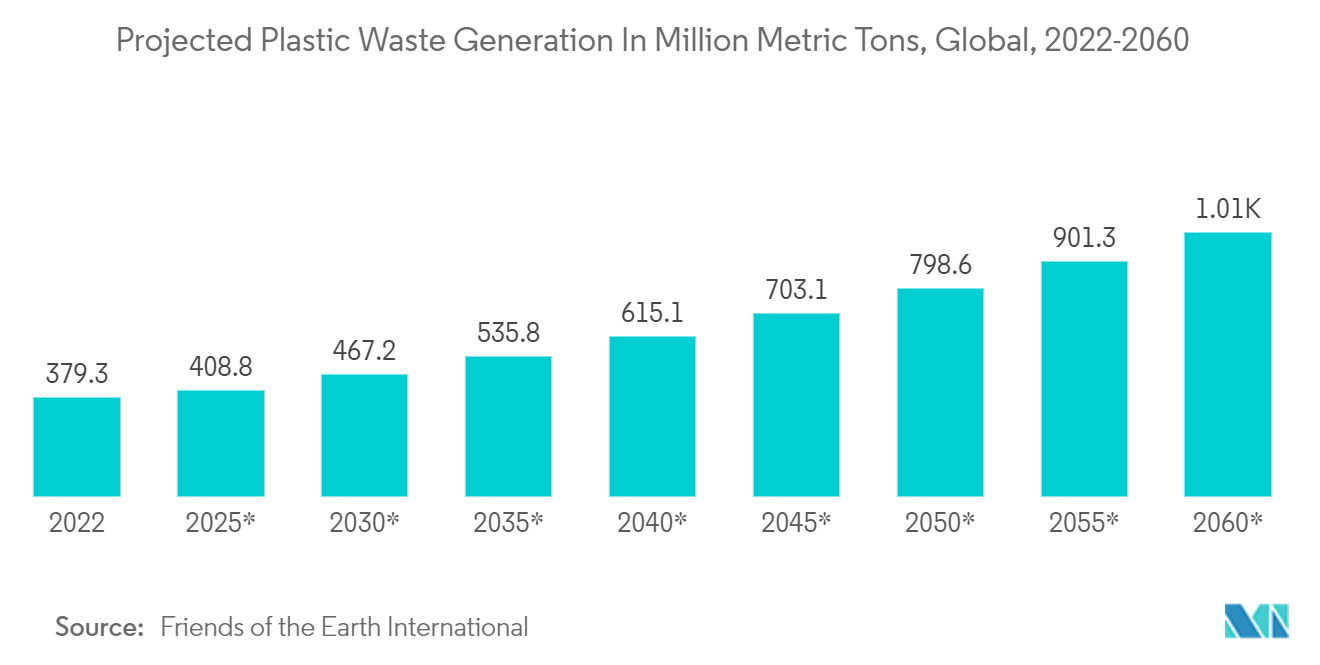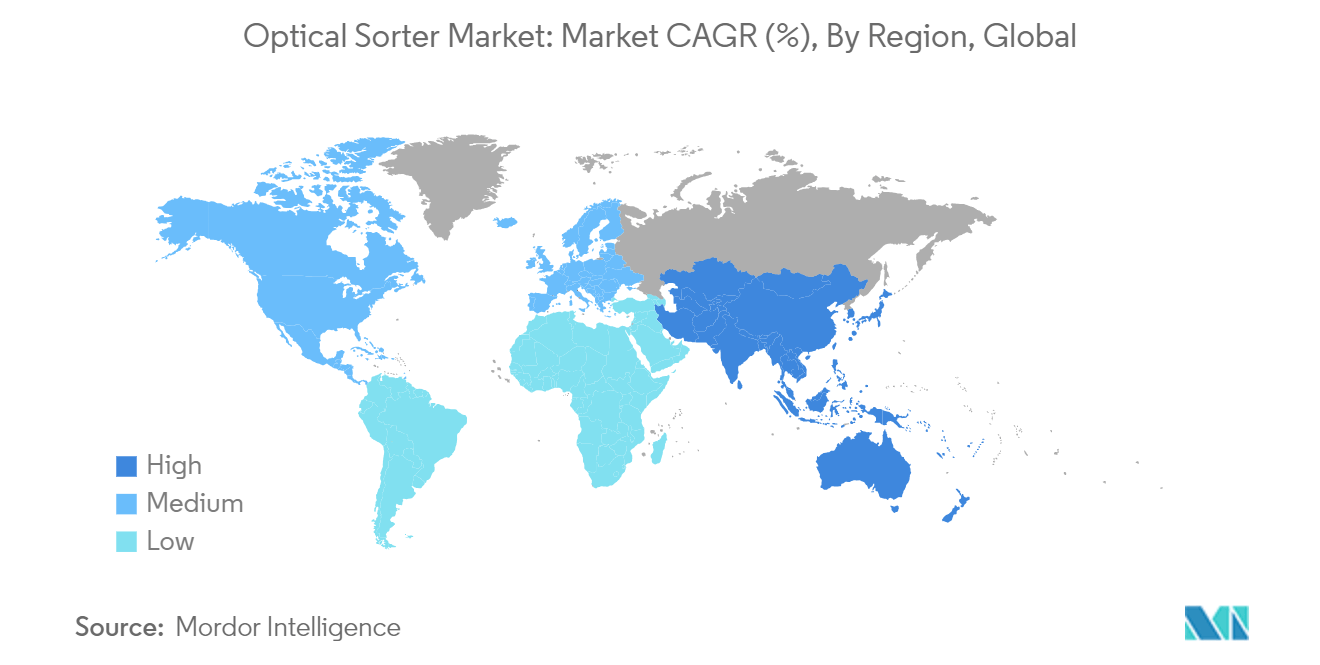Market Trends of Optical Sorter Industry
Food Industry to Hold Significant Market Share
- The recycling segment includes the study of various technologies, such as X-ray transmission, camera solutions, laser, and NIR sensors, used in the recycling industry for efficient sorting processes worldwide. The recycling segment covered as a part of the study includes metal and scrap recycling, municipal waste recycling, electronic waste recycling, different types of plastic waste recycling, and textile waste recycling.
- Optical waste sorting is a contemporary and environmentally conscious recycling technique that leverages advanced camera systems, sensors, and machine learning algorithms. These technologies swiftly and precisely identify and categorize various waste materials for optimal disposal or recycling. The process is user-friendly, employing color-coded bags tailored to different recyclable materials. Users simply deposit these bags into a common waste bin or inlet. Subsequently, at the sorting plant, the bags are segregated by color and directed to their respective containers.
- Optical sorters have revolutionized the recycling industry by enhancing waste management processes' efficiency, accuracy, and overall effectiveness. They employ advanced camera systems, sensors, and machine learning algorithms to efficiently and accurately identify and sort various waste materials. These systems can detect the unique spectral signatures of different materials, allowing for precise identification and separation. This technology is particularly useful for sorting post-consumer waste, including plastics, glass, paper, and metal.
- An optical sorting system can be used with the automated waste collection system or can be added to traditional methods of waste collection to modernize them. For instance, Envac has, in collaboration with the Grow Smarter project at Valla Torg, Stockholm, achieved a significant 65% reduction in household general waste. This achievement followed the company's overhaul of traditional recycling methods.
- The newly implemented system tracks weight per fraction, monitors user sorting efficiency, and assesses the disposal methods of recyclables. By leveraging this data, Envac has optimized the system, surpassing conventional standards. Technological advancements allow precise configuration of the system's capacity and collection intervals, enhancing recycling rates and establishing the system as both sustainable and intelligent.
- Governments and international organizations worldwide are taking significant measures to reduce plastic waste, which is creating a significant demand for the implementation of optical sorters. For instance, in 2023, the UN Environment Program (UNEP) unveiled a roadmap, proposing measures to reduce global plastic pollution by 80% by 2040. This target is achievable and contingent on nations and corporations embracing substantial policy and market changes and leveraging technologies already at their disposal.
- The OECD forecasts a tripling of global plastic waste generation by 2060, surpassing a staggering one billion metric tons. This surge is primarily attributed to burgeoning populations and economic expansion.
- Companies are developing innovative solutions to remain competitive in the technologically advanced market and cater to customers' varying needs. For instance, in July 2024, Cimbria, a Denmark-based company, released new optical sorters that provide advanced sorting of plastics with precise material separation to enable the purification of up to 99.99% of the sorted plastic.

Asia Pacific to Register Major Growth
- Optical sorters are significantly witnessing increasing demand in the Asia-Pacific due to a growing emphasis on food safety and waste management. This trend is particularly evident in countries like China, India, and Japan, where the demand for efficient sorting solutions is on the rise.
- The integration of advanced technologies such as AI, machine learning, and hyperspectral imaging has significantly enhanced optical sorters' capabilities. These innovations allow for more precise sorting of various materials, including food products, plastics, and metals, which is crucial for industries looking to improve efficiency and reduce waste.
- With rising consumer awareness regarding food safety, the food processing industry in Asia-Pacific is increasingly adopting optical sorting technologies. These systems ensure that only high-quality products reach consumers by effectively removing defective items and containments during processing. This is particularly important in countries with large agricultural sectors, where maintaining quality is essential for both domestic consumption and export.
- South Korea's food and beverage market offers tremendous potential for international players and brands. As the 10th largest economy with a high per-capita GDP, South Korea presents a lucrative opportunity for the market. The country has over 48,000 convenience stores (CVS) across the country with major players, including GS25 (GS Holdings Corp.), CU (BFG Retail), and 7-Eleven (including Ministop, Lotte Group). Thus, the growing food & beverage industry in the country is expected to add lucrative growth opportunities for the market studied.
- Moreover, India's food ecosystem offers immense investment opportunities by stimulating growth in the food retail sector, promoting economic policies, and attractive fiscal incentives. The Government of India has taken all necessary measures to encourage investments in the Indian food processing industry through the Ministry of Food Processing Industries (MoFPI). For example, Pradhan Mantri Kisan Sampada Yojana (PMKSY) aims to develop a modern food processing infrastructure.
- Moreover, the food and beverage industry in Japan is also prospering owing to factors such as a higher share of the urban population and changing food consumption habits, among others. For instance, according to the Global Organic Trade Guide, the consumption of packaged organic food in Japan is anticipated to reach a value of USD 427.1 million by 2025, compared to USD 401.4 million in 2018.


